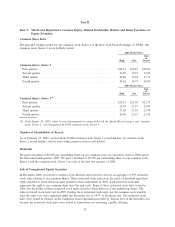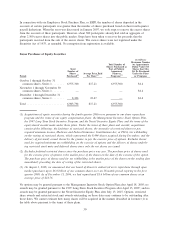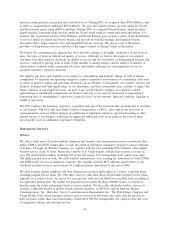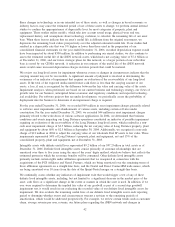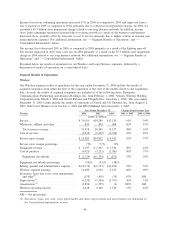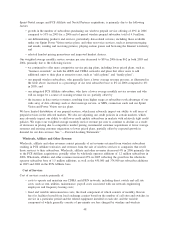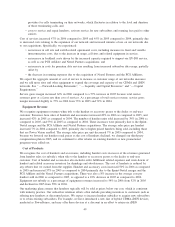Sprint - Nextel 2006 Annual Report Download - page 41
Download and view the complete annual report
Please find page 41 of the 2006 Sprint - Nextel annual report below. You can navigate through the pages in the report by either clicking on the pages listed below, or by using the keyword search tool below to find specific information within the annual report.expenses are dependent on the number of subscriber additions and the nature and extent of our marketing and
promotional activities. Customer care costs are dependent on the number of subscribers that we serve and the
nature of programs designed to serve and retain subscribers. General and administrative expenses consist of
fees paid for billing, customer care and information technology operations, bad debt expense, customer
retention and back office support activities, including collections, legal, finance, human resources, strategic
planning and technology and product development, along with the related payroll and facilities costs. Although
our goal is to improve operating margins through cost savings initiatives and benefits of scale, costs that
fluctuate based on network utilization and the number of subscribers that we serve and costs associated with
enhancing and expanding the coverage of our network generally will increase in absolute terms over time. We
also seek to realize operating efficiencies in our business from merger-related cost savings and other synergies.
In February 2005, Nextel accepted the terms and conditions of the Report and Order, which implemented a
spectrum reconfiguration plan designed to eliminate interference with public safety operators in the 800 MHz
band. Under the terms of the Report and Order, Nextel surrendered certain spectrum rights and received
certain other spectrum rights, and undertook to pay the costs incurred by Nextel and third parties in connection
with the reconfiguration plan, which is required to be completed within a 36-month period, subject to certain
exceptions particularly with respect to markets that border Mexico and Canada. We assumed these obligations
when we merged with Nextel in August 2005. If, as a result of events within our control, we fail to complete
the reconfiguration plan within the 36-month period, the FCC could take actions against us to enforce the
Report and Order. These actions could have adverse operating or financial impacts on us, some of which could
be material. We believe that, based on our experiences to date, we will not complete the reconfiguration
process within the 36-month period due to events largely outside of our control. We do not believe at this time
that the impact from this delay will be material to our results of operation or financial condition, although
there can be no assurance. Recognizing the current limitations in the reconfiguration process, both Sprint
Nextel and the public safety community jointly filed a letter with the FCC on February 15, 2007 requesting
that the FCC direct the Transition Administrator, through working closely with the affected parties, to develop
a schedule and benchmarks for completing the second phase of the 800 MHz reconfiguration. See
“— Forward-Looking Statements.”
As part of the reconfiguration process in most markets, we must cease using portions of the surrendered 800
MHz spectrum before we are able to commence use of replacement 800 MHz spectrum, which has contributed
to the capacity constraints experienced on our iDEN network, particularly in some of our more capacity
constrained markets, and has impacted performance of our iDEN network in the affected markets.
Based on the FCC’s determination of the values of the spectrum rights received and surrendered by Nextel, the
minimum obligation to be incurred under the Report and Order is $2.8 billion. The Report and Order also
provides that qualifying costs we incur as part of the reconfiguration plan, including costs to reconfigure our
own infrastructure and spectrum positions, can be used to offset the minimum obligation of $2.8 billion;
however, we are obligated to pay the full amount of the costs relating to the reconfiguration plan, even if those
costs exceed that amount.
In addition, a financial reconciliation is required to be completed at the end of the reconfiguration
implementation, at which time we will be required to make a payment to the U.S. Treasury to the extent that
the value of the spectrum rights received exceeds the total of (i) the value of spectrum rights that are
surrendered and (ii) the qualifying costs referred to above. As a result of the uncertainty with regard to the
calculation of the credit for our internal network costs, as well as the significant number of variables outside
of our control, particularly with regard to the 800 MHz reconfiguration licensee costs, we do not believe that
we can reasonably estimate what amount, if any, will be paid to the U.S. Treasury.
As required under the terms of the Report and Order, we delivered a $2.5 billion letter of credit to provide
assurance that funds will be available to pay the relocation costs of the incumbent users of the 800 MHz
spectrum. Although the Report and Order provides for the possibility of periodic reductions in the amount of
the letter of credit, no reductions have been made as of December 31, 2006.
39


